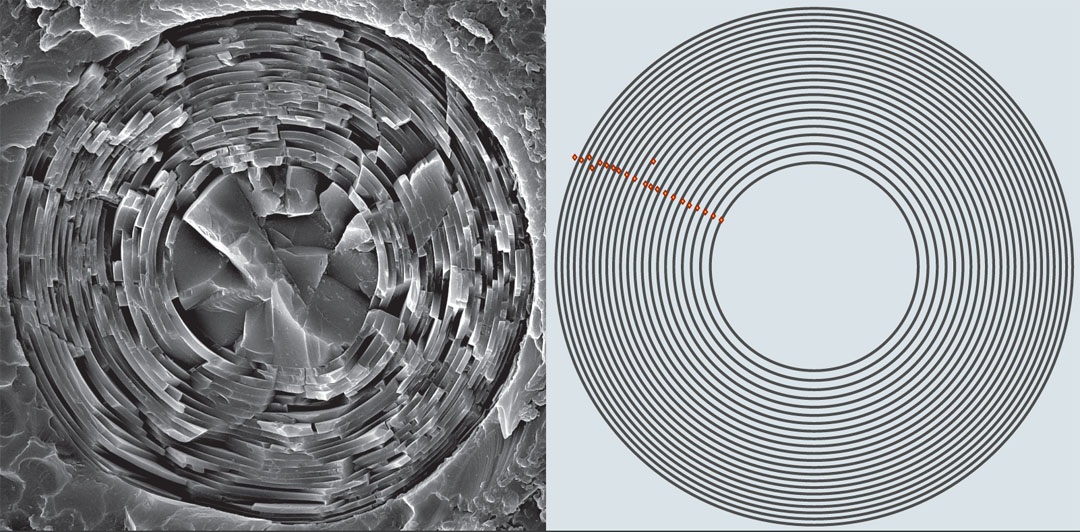PROVIDENCE, R.I. [Brown University] — Life may seem precarious for the sea sponge known as Venus’ flower basket. Tiny, hair-like appendages made essentially of glass are all that hold the creatures to their seafloor homes. But fear not for these creatures of the deep. Those tiny lifelines, called basalia spicules, are fine-tuned for strength, according to new research led by Brown University engineers.
In a paper published in the Proceedings of the National Academy of Sciences, the researchers show that the secret to spicules’ strength lies in their remarkable internal structure. The spicules, each only 50 microns in diameter, are made of a silica (glass) core surrounded by 10 to 50 concentric cylinders of glass, each separated by an ultra-thin layer of an organic material. The walls of each cylinder gradually decrease in thickness moving from the core toward the outside edge of the spicule.

A mathematical model, right, predicted that the thickness of nested glass cylinders should decrease from the core to the exterior to optimize strength. Studies of hundreds of spicules, left, showed that was exactly the case in nature.
When Haneesh Kesari, assistant professor of engineering at Brown, first saw this structure, he wasn’t sure what to make of it. But the pattern of decreasing thickness caught his eye.
“It was not at all clear to me what this pattern was for, but it looked like a figure from a math book,” Kesari said. “It had such mathematical regularity to it that I thought it had to be for something useful and important to the animal.”
The lives of these sponges depend on their ability to stay fixed to the sea floor. They sustain themselves by filtering nutrients out of the water, which they cannot do if they’re being cast about with the flow. So it would make sense, Kesari thought, that natural selection may have molded the creatures’ spicule anchors into models of strength — and the thickness pattern could be a contributing factor.
“If it can’t anchor, it can’t survive,” Kesari said. “So we thought this internal structure must be contributing to these spicules being a better anchor.”
To find out, Kesari worked with graduate student Michael Monn to build a mathematical model of the spicules’ structure. Among the model’s assumptions was that the organic layers between the glass cylinders allowed the cylinders to slide against each other.
“We prepared a mechanical model of this system and asked the question: Of all possible ways the thicknesses of the layers can vary, how should they vary so that the spicule's anchoring ability is maximized?” Kesari said.
The model predicted that the structure’s load capacity would be greatest when the layers decrease in thickness toward the outside, just as was initially observed in actual spicules. Kesari and Monn then worked with James Weaver and Joanna Aizenberg of Harvard’s Wyss Institute for Biologically Inspired Engineering, who have worked with this sponge species for years. The team carefully compared the layer thicknesses predicted by the mechanics model to the actual layer thicknesses in more than a hundred spicule samples from sponges.
The work showed that the predictions made by the model matched very closely with the observed layer thicknesses in the samples. “It appears that the arrangement and thicknesses of these layers does indeed contribute to the spicules’ strength, which helps make them better anchors,” Kesari said.
The researchers say this is the first time to their knowledge that anyone has evaluated the mechanical advantage of this particular arrangement of layers. It could add to the list of useful engineered structures inspired by nature.
“In the engineered world, you see all kinds of instances where the external geometry of a structure is modified to enhance its specific strength — I-beams are one example,” Monn said. “But you don’t see a huge effort focused toward the internal mechanical design of these structures.”
This study, however, suggests that sponge spicules could provide a blueprint for load-bearing beams made stronger from the inside out.
The research was supported by grants from the National Science Foundation (DMR-0520651, DMR- 1420570) and the KIMM–Brown Nano and Micromechanics for Disaster Mitigation and Technological Reliability project.

